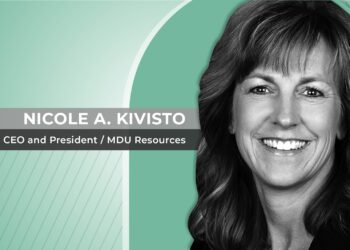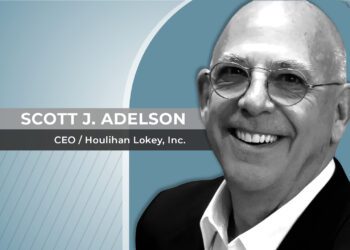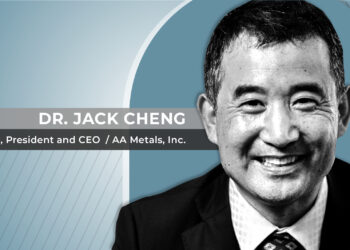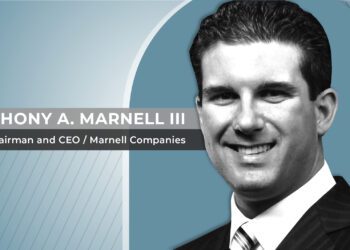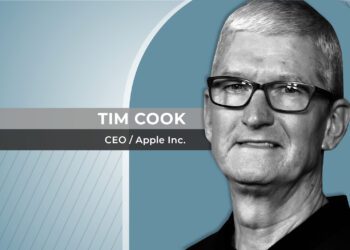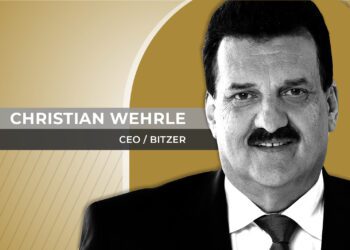As president of U.S. operations for National Grid, Badar Khan returned from the COP26 summit in Glasgow even more convinced of the urgency facing the utility industry in terms of executing an historic clean energy transition.
By Anthony Moran
Much has been said and written about the relative impact of the 2021 UN Climate Change—or COP26—held in Glasgow, Scotland, in November, yet Badar Khan, president of National Grid U.S., says he came away from the event feeling really positive as to what can be achieved in the coming years. “To be honest, I wasn’t really sure what would come from it, but I was delighted,” Khan told CEO Magazine North America in an exclusive interview. “It was my first COP and I kept bumping into people for whom it was also their first. A lot of them were, like me, business leaders, but there were also a lot of finance executives, and I think that was really good because typically company executives are trained to talk about what we’ve done as opposed to what they’re going to do. Yet there was a lot of dialogue around what people have been doing and are doing as well as their roadmaps for the future.”
Playing a role in the historic transition to a clean energy future was one of the key elements that appealed to Khan when he was appointed president of National Grid USA in November 2019. Yet he was also taking on the responsibility of a leadership role at one of the largest investor owned utility companies in the world, which as part of its U.S. operations supplies electricity and gas to more than 20 million people in New York and New England.
Founded in 1990, National Grid plc is a British multinational electricity and gas utility company headquartered in London, England. It operates in the United Kingdom and in the Northeastern United States. It has a primary listing on the London Stock Exchange where it is a constituent of the FTSE 100 Index, and a secondary listing in the form of its American depositary receipts on the New York Stock Exchange.
THREE OPPORTUNITIES
Khan says he essentially saw three major opportunities when he took on the role of president for National Grid USA. The transition to clean energy throughout the U.S. power grid and the utilities industry more generally appealed greatly to his vision for the future of the industry. Yet the others were perhaps less obvious: Khan says he was deeply enthusiastic about what he could bring to National Grid USA in terms of progress in diversity, equity, and inclusion (DEI) as well as strengthening the emphasis the company already had on innovation and customer service.
“On the issue of the clean energy transition, the key thing is that this is a generational level change that we’re going through and utilities will play an incredibly important role in shaping it,” outlined Khan. “I’m proud that National Grid is stepping up to help stop the planet warming. We believe reducing emissions to net zero is the primary lever and I think our role as a utility company is similar to the important societal roles that utilities have played in the past. In the early 1930s, less than 10% of rural America had access to electricity. In less than 30 years, we increased that to 90%. I think utilities can also have that kind of major impact in terms of clean energy today.”
“As far as DEI, I think about the impact our company can have in terms of three categories,” Khan explained as far as his dedication to boosting diversity, equity, and inclusion. “Those are: the impact inside our company, the impact within our ecosystem, and the impact we can have within our communities. Within the company, we have tripled the resources we dedicate to our DEI efforts, which includes the appointment of a new Chief Diversity, Equity & Inclusion Officer. As a large company with a large supply chain, we can promote those values within our ecosystem as well. The third part is making sure that the clean energy transition doesn’t leave marginalized communities behind.
“On innovation and customer focus, the key question is how can we remain agile and meet our customers’ ever evolving expectations? I remember reading a quote from Jeff Bezos where he said that the day Amazon fails is the day it starts ignoring its customers. A company’s success comes through constantly focusing on its customers’ needs. That really resonates for me. We’re a large company with 17,000 employees in the U.S., but we need to look outward and not just inward.”
A CLEAN ENERGY FUTURE
Khan has a clear vision when it comes to where he believes the priorities lie in our planet’s historic transition to clean energy. National Grid publicly announced its goals to reduce carbon emissions to net zero in 2019 and has already lowered its emissions by approximately 70% compared to 30 years ago. Yet Khan was keen to emphasize that the emissions the company produces directly from its own operations are only 20% of the total emissions it can influence as a company.
“For us, what’s important is the role companies like ours can play and are playing in the transition to this new clean energy future,” he insisted. “When you look across different economic sectors, indirect emissions are often coming from your supply chain. How do large corporates like ourselves track emissions across our supply chain? I think in the coming years you’re going to see a lot more focus on sustainability in companies’ supply chains.”
“A lot of companies don’t include indirect emissions in their emissions reduction commitments because they can’t control them as easily, but we do include them” Khan elaborated. “We felt it was important to take on that responsibility and we’ve published a report that focuses on 10 different areas in which we can reach net zero by 2050, but they broadly span three sectors: decarbonizing energy supply, decarbonizing transportation, and decarbonizing building heat. For example, we want to get to at least 80% zero-carbon electricity supply by 2030.”
“We’ve signed contracts with offshore wind generators to supply roughly half of our Massachusetts and Rhode Island customers’ load by the mid 2020s,” he said. “Onshore, we’ve already connected about 100,000 solar and battery systems across our territory which I believe makes it the second largest amount of large scale non-residential interconnected solar by any utility in the U.S. Every year we provide about half a billion dollars in incentives for customers to make their homes more energy efficient and we want to double the rate of energy efficiency in our territory by 2030.
“Over the past decade we’ve seen a great deal of emissions reduction within the industry itself, but in the coming years I believe we need to work harder to engage the consumer to also make the right choices whether it’s through embracing EVs or changing the way they power their homes. Everybody has to play a role.”
THE GREEN SUPERHIGHWAY
As proof of the company’s commitment, National Grid is putting its money where its mouth is with regards to clean energy. A few years ago, the company launched a corporate venture capital arm known as NG Partners which has allocated $400 million of shareholder funds and thus far invested over $300 million in technology to aid the clean energy transition, whether that is AI and analytics, IoT, or smart grid technology—all the way through to helping customers manage their energy at home.
“In the U.S. specifically, we’re looking at an investment of around $14 billion in our New York utilities and around $10 billion in our New England utilities over the next five years,” Khan highlighted. “About half of that is investment in our gas utilities, a quarter in electric transmission, and a quarter in electric distribution. On gas, about 80% of that investment will be put towards replacing existing infrastructure. That’s good for the environment because we’re eliminating methane leaks into the atmosphere, but it’s also good from a safety perspective.”
“We’re also investing in what we call clean gas,” he elaborated. “These are small-scale pilots for now, but we’re getting to a place where we’ll move into renewable natural gas and green hydrogen blending, which is key to meeting our goals. All of this is based on our belief in the growth of the market for renewable energy. It’s a policy priority right now for both President Biden and the states we operate in. The government of New York State, in particular, has been talking about what they call a green superhighway to connect renewable supply in Upstate New York to the concentration of where people live and work in Downstate New York.”
BENEFITING THE CUSTOMER
Alongside the bigger picture of reducing carbon emissions for the good of the planet, Khan is adamant that consumers of energy will benefit from the clean energy transition in a variety of ways. Again, he believes technology will play a key role, whether it is producing a lower cost and lower maintenance supply of energy, digitizing and automating formerly paper-based and time consuming administrative tasks, or simply making it easier for customers to monitor their energy use, pay bills, and report problems.
“When we talk about digitization, we’re talking about users working side by side with developers,” he concluded. “Coming up with ideas quickly, testing them quickly, iterating those ideas with customers, and you’re actually delivering functionality faster and in a way that it’s more likely to meet the needs that you’ve set out. That’s an important part of any company’s digitization journey.”


